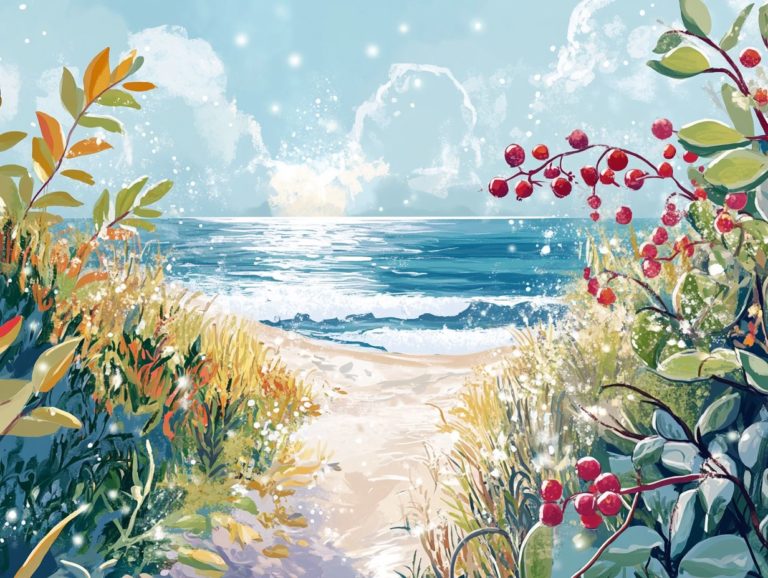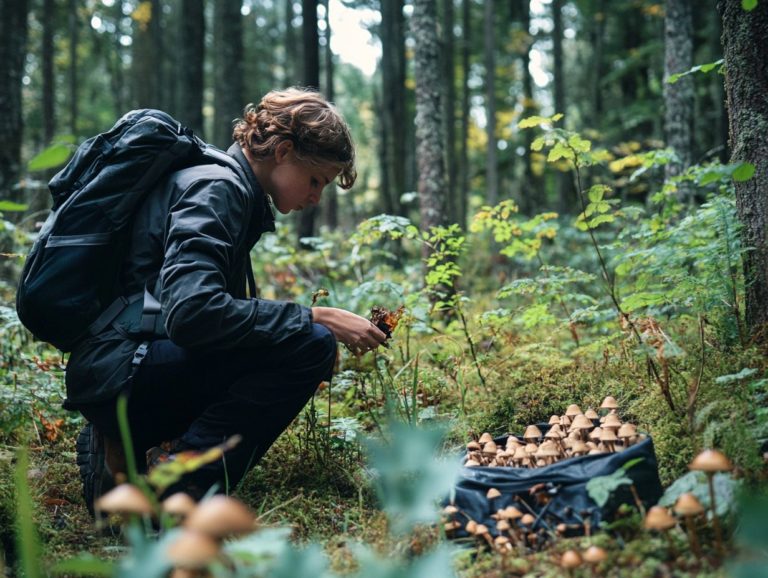How to Integrate Foraging into My Diet?
Foraging is more than a culinary trend. It s a journey into the wild that connects you with nature and your food sources, including wild edibles and the art of backyard foraging.
This exploration reveals the true essence of foraging and its many benefits. These include enhancing your nutrition and promoting environmental sustainability. You will also learn to identify edible plants like dandelions and mushrooms while prioritizing safety and ethical practices during your foraging adventures.
Get ready to be inspired! Discover delightful recipes that showcase foraging s power to elevate your meals and minimize food waste, incorporating seasonal foods and wild greens. Dive into the captivating world of foraged foods and unlock a new dimension of culinary delight!
Contents
- Key Takeaways:
- Understanding Foraging
- The Benefits of Foraging
- How to Incorporate Foraging into Your Diet
- Foraging Recipes and Meal Ideas
- Creative Ways to Use Foraged Foods
- Foraging as a Sustainable Lifestyle
- Frequently Asked Questions
- What is foraging and how can I integrate it into my diet?
- What are the benefits of incorporating foraging into my diet?
- How can I start foraging for food?
- What are some common foods I can forage for?
- Can I integrate foraging into my diet if I live in a city?
- Are there any safety precautions I should take when foraging?
Key Takeaways:

- Foraging is the act of gathering wild edible plants and fungi.
- Incorporating foraging can provide access to nutrient-rich foods.
- To forage safely, learn to identify edible plants and follow food safety guidelines.
Understanding Foraging
Understanding foraging means embracing the art of gathering wild edibles. This includes a variety of edible plants, mushrooms, and even insects as food.
Foraging transcends mere survival skills. It embodies a lifestyle enriched by local flora and seasonal foods, fostering a profound connection to the environment.
You can learn to identify various plants and mushrooms through hands-on training and community engagement. This promotes a self-sustaining lifestyle while honoring the ecosystem.
Ultimately, foraging elevates your nutritional intake while cultivating a sense of community through shared experiences in outdoor learning and food gathering.
What is Foraging?
Foraging is the art of searching for and gathering wild edibles. This includes a delightful mix of edible plants, mushrooms, and other natural treasures like the cambium layer of trees.
This ancient practice traces back to prehistoric times when early humans depended on the land s bounty for survival. They refined their ability to identify safe plants like willow and maple.
As societies evolved, foraging transformed from a mere survival tactic into a way to enrich diets with seasonal flavors and herbal medicine.
Today, many individuals are rediscovering this timeless practice as a means to reconnect with nature. Urban foraging allows exploration of local ecosystems while elevating culinary experiences.
By honing foraging skills, including plant identification and cooking techniques, you cultivate a deeper appreciation for edible plants and their ecological significance. You also embrace a more sustainable lifestyle by sourcing food directly from the earth.
The Benefits of Foraging
The benefits of foraging extend beyond gathering food. They encompass enhanced nutritional value, environmental conservation, and a dedication to a sustainable lifestyle.
When you forage, you can source nutrient-rich foods, including wild greens and mushrooms, directly from your local environment. Learning how to use foraging techniques in cooking fosters a profound connection with nature while promoting biodiversity.
Engaging in foraging enriches your diet and supports local ecosystems. It encourages cooking methods that minimize waste and highlights the significance of community ties in sustainable food sourcing.
Nutritional and Environmental Benefits

The nutritional and environmental benefits of foraging are truly remarkable. You gain access to fresh, nutrient-rich foods like wild berries, while also promoting biodiversity and fostering healthy ecosystems.
As you embark on a foraging adventure, indulge in a variety of wild edibles, including pine needles and dandelion leaves. These are brimming with vitamins, minerals, and antioxidants, all vital for enhancing your overall health.
By choosing to gather these natural foods, you bolster your personal well-being and play an active role in conserving diverse plant species. This practice deepens your connection to nature and helps reduce food waste, as you often make use of seasonal produce. It also encourages outdoor learning experiences that might otherwise be overlooked.
By preserving your foraged findings through various food preservation techniques, you minimize your carbon footprint and champion a sustainable future while nurturing the delicate balance of local ecosystems.
How to Incorporate Foraging into Your Diet
Incorporating foraging into your diet requires a keen understanding of how to identify edible plants and mushrooms, including wild edibles like morels. You’ll need to master the appropriate cooking techniques and food safety practices to prepare them safely. Learning how to use foraging in culinary arts while being mindful of their seasonal availability will truly enhance your healthy cooking.
Identifying Edible Plants and Fungi
Identifying edible plants and fungi, such as wild mushrooms and dandelions, is essential for your foraging journey. It requires a solid understanding of local resources, seasonal availability, and safe mushroom hunting practices.
As a foraging enthusiast, you can explore a diverse array of species, such as morels, dandelions, wild greens, and even edible flowers, while employing various techniques for accurate identification. Resources like foraging guides, foraging clubs, and smartphone apps significantly enhance your ability to recognize these plants and mushrooms in their natural habitat.
Field guides offer vivid imagery and detailed descriptions, helping you distinguish between what s edible, like wild fruits, and what s toxic. Always prioritize your safety!
Engaging with local foraging groups, such as the Indiana Mycological Society, further enriches your learning experience. This fosters a sense of community as you embark on the adventure of discovering nature’s bounty together.
Foraging Safety and Ethics
Safety and ethics in foraging are essential for an exciting adventure! Ensure that wild food gathering is conducted responsibly, honoring both the local flora, including wild mushrooms, and the environment.
By embracing sustainable harvesting practices which means taking only what you need without harming the environment you protect biodiversity while enjoying nature s rich bounty. This includes ensuring enough resources for wildlife and the future growth of plants like maple and willow.
It’s vital to educate yourself about local ecosystems, recognizing which plants, such as herbs used in traditional medicine, are native. Understand how their removal could impact the surrounding habitat.
Maintaining connections within your community through shared knowledge fosters a sense of responsibility among foragers. This encourages the exchange of tips on safe foraging and preparation techniques.
Ethical foraging enriches your diet, strengthens community ties, and deepens your appreciation for the environment while contributing to local food sourcing initiatives.
Foraging Recipes and Meal Ideas

Foraging recipes and meal ideas offer you a wealth of inspiration for incorporating wild edibles, like wild berries and mushrooms, into your culinary creations. These recipes highlight the versatility of foraged ingredients while enhancing your food preservation techniques, including preserving food through canning methods.
Try these recipes today and discover the joys of foraging!
Creative Ways to Use Foraged Foods
There are countless creative ways to incorporate foraged foods, including edible flowers, into your meals. Whip up a nutritious salad with wild greens or add mushrooms to hearty dishes.
Exploring these wild edibles can significantly elevate the flavors and textures of your cooking. Insects can also provide a wealth of vitamins and minerals often missing from store-bought options. For instance, adding dandelion leaves or wild greens not only enhances the nutritional profile of your meal but also introduces unique flavor notes, transforming a simple dish into a gourmet experience.
Foraged ingredients like berries can be transformed into innovative desserts, delivering natural sweetness and vibrant color. Embrace these elements and explore creative cooking methods to turn your kitchen into a playground for culinary experimentation, elevating your creations to new heights.
Foraging as a Sustainable Lifestyle
Foraging as a sustainable lifestyle invites you to embrace the art of gathering wild edibles, including those found in urban areas. This practice helps reduce food waste and supports local ecosystems, enriching your connection to the natural world. Additionally, exploring the benefits of seasonal foraging for your diet can enhance your culinary experience.
By engaging with nature s bounty, you foster a sense of community and appreciation for the resources around you.
Reducing Food Waste and Supporting Local Ecosystems
Reducing food waste through foraging cultivates a sustainable lifestyle and supports local ecosystems by promoting biodiversity. This practice strengthens community connections.
Actively seeking out wild edibles unlocks a treasure trove of food sources, such as the soft layer and inner bark of trees, that might otherwise go unnoticed. This minimizes the amount of edible matter that ends up as waste. Engaging in foraging deepens your appreciation of local biodiversity as you familiarize yourself with the plants that thrive in your area.
Foraging encourages collaboration within the community. Share tips about seasonal finds and sustainable harvesting methods to strengthen bonds and foster a collective commitment to environmental stewardship. Together, these practices weave a tapestry of resilience and interconnection within the local ecosystem.
Frequently Asked Questions

What is foraging and how can I integrate it into my diet?
Foraging refers to gathering wild food sources such as fruits, nuts, and edible plants. You can easily integrate these foods into your meals or snacks by learning how to use foraged ingredients in cooking.
What are the benefits of incorporating foraging into my diet?
Foraging allows you to consume fresh, nutrient-dense foods that are free from pesticides and harmful chemicals. It also promotes a more sustainable, eco-friendly way of eating.
How can I start foraging for food?
Begin by educating yourself on the types of foods that are safe to forage in your area. Join local foraging groups or workshops to learn from experienced foragers. Always make sure to properly identify the plants before consuming them.
What are some common foods I can forage for?
Common foods that can be foraged include berries, mushrooms, wild greens, and nuts. It’s best to research which plants are safe to forage in your specific region.
Can I integrate foraging into my diet if I live in a city?
Yes! Even if you live in a city, you can forage for urban edible plants like dandelion greens, elderflowers, and wild berries. Just avoid areas with heavy pollution or pesticide use.
Are there any safety precautions I should take when foraging?
Yes, it’s important to be cautious when foraging. Always properly identify the plants before consuming them. Avoid foraging near busy roads or contaminated areas. It’s best to forage with an experienced guide or do thorough research before heading out on your own.






